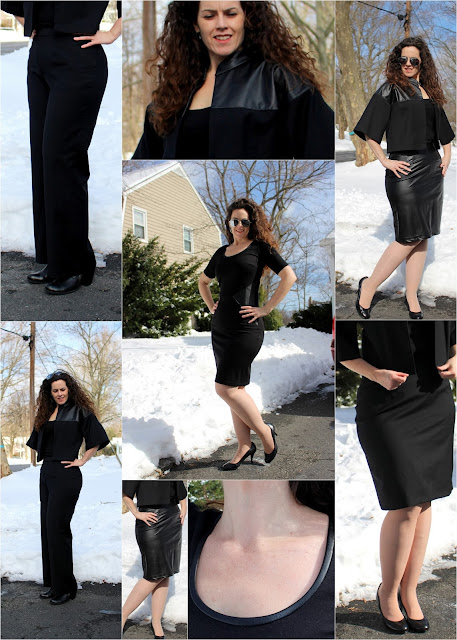Life and sewing are funny. Somehow I find myself super excited about what might be the most sensible and boring sewing project that I've ever undertaken. Back in January I posted about how my plan to sew trousers exploded into a mini-wardrobe project. Well, here are the results.
If you follow me on IG, you might remember that back in September I redrafted a pencil skirt pattern from Kenneth King's The Skirts. It's more basic than my normal sewing but will lend itself to lots of style manipulation. This is the wearable muslin that I made but never blogged.
But I set it aside temporarily to work on what I really need: more trousers! I used BurdaStyle 9/2010 #115, which is a tall pattern, to make a pair of lined trousers. You've already seen my gold wool trousers from this pattern, which was actually my second version.
For this first version, I pulled out a large cut of black cotton blend suiting from stash to sew up a hopefully wearable muslin. After some final tweaks, the fit turned out to be nearly perfect. So, not a wearable muslin at all.
Encouraged by my success, I started playing with the suiting fabric and realized that I had more than enough to also make a pencil skirt using my newly drafted pattern and potentially a cute little jacket, too.
And thus was born my mini wardrobe for work. I used OOP Butterick B5567, which I have been meaning to sew for about a year, to make a cute little jacket to go with the skirt and trousers - a 3 piece wardrobe. Since I had some faux leather in my stash, I decided to jazz up the jacket with some faux leather parts, as you can see.
But why stop there? I had enough faux leather for a skirt too! Admittedly, it came out a bit clingy. Maybe it will be saved for date night since Phin seemed to approve.
And since I had a smidge more faux leather and some ponte, I decided to round out the whole thing with a dress.
So, there you have it. My quest to fit my bottom half inadvertently led to a mini-wardrobe project! More on each of these makes in the coming days, but I'll leave you with one more collage of the five pieces.
Behold!! It's my 5 piece mini wardrobe primarily for work, composed of a jacket, a dress, trousers and two skirts. A little recap on how this all happened...
If you follow me on IG, you might remember that back in September I redrafted a pencil skirt pattern from Kenneth King's The Skirts. It's more basic than my normal sewing but will lend itself to lots of style manipulation. This is the wearable muslin that I made but never blogged.
But I set it aside temporarily to work on what I really need: more trousers! I used BurdaStyle 9/2010 #115, which is a tall pattern, to make a pair of lined trousers. You've already seen my gold wool trousers from this pattern, which was actually my second version.
For this first version, I pulled out a large cut of black cotton blend suiting from stash to sew up a hopefully wearable muslin. After some final tweaks, the fit turned out to be nearly perfect. So, not a wearable muslin at all.
 |
| Wow, I don't really love these shoes with these trousers. Oh well. |
Encouraged by my success, I started playing with the suiting fabric and realized that I had more than enough to also make a pencil skirt using my newly drafted pattern and potentially a cute little jacket, too.
And thus was born my mini wardrobe for work. I used OOP Butterick B5567, which I have been meaning to sew for about a year, to make a cute little jacket to go with the skirt and trousers - a 3 piece wardrobe. Since I had some faux leather in my stash, I decided to jazz up the jacket with some faux leather parts, as you can see.
But why stop there? I had enough faux leather for a skirt too! Admittedly, it came out a bit clingy. Maybe it will be saved for date night since Phin seemed to approve.
And since I had a smidge more faux leather and some ponte, I decided to round out the whole thing with a dress.
So, there you have it. My quest to fit my bottom half inadvertently led to a mini-wardrobe project! More on each of these makes in the coming days, but I'll leave you with one more collage of the five pieces.




































